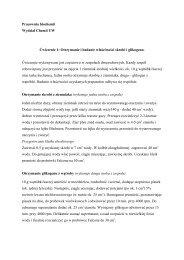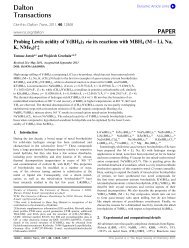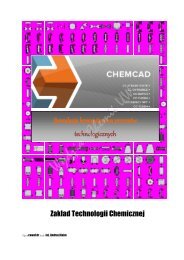Chem. Anal. (Warsaw), 53, 759
Chem. Anal. (Warsaw), 53, 759
Chem. Anal. (Warsaw), 53, 759
You also want an ePaper? Increase the reach of your titles
YUMPU automatically turns print PDFs into web optimized ePapers that Google loves.
760 Z. Hubicki, M. Wawrzkiewicz and A. Wo³owicz<br />
Ion exchange chromatography has become a valuable or even irreplaceable method<br />
of noble metal ions separation in analytical chemistry and chemical technology. This<br />
has been accomplished owing to the common use of ion-exchange resin methods,<br />
which are indispensable in many fields of chemical industry, including analytical<br />
chemistry. Recently, ion exchange chromatography has developed largely as a result<br />
of availability of new types of commercially available ion exchangers, two types of<br />
which are widely applied: selective and modified ion exchangers on the one hand and<br />
liquid ion exchangers on the other hand.<br />
Separation of noble metal ions is extremely difficult due to the fact that precious<br />
metals occur as aggregates in nature forming isomorphous mixtures of the significant<br />
chemical affinity. Most of these metals occur at various oxidation states. Moreover,<br />
they easily form various complex compounds; the corresponding formation equilibria<br />
between aqua-complexes of different composition and charge are frequently complex.<br />
Platinum group metals (PGM) can also form polynuclear complexes and complexes<br />
with mixed ligands. The above facts make separation of these elements difficult.<br />
Moreover, the quality of separation depends on composition and origin of the<br />
solution. As a result, the relevant literature data are contradictory in some cases and<br />
separations reported in the literature are not fully quantitative [1]. Because of small<br />
amounts of platinum group metals in nature and impoverishment of their natural<br />
resources, physicochemical methods are of great importance for recovery of PGM<br />
from secondary sources e.g. used up three-way catalysts, dental alloys, industrial<br />
waste waters. One of these methods is ion exchange chromatography. Ion-exchange<br />
separations of palladium, platinum, rhodium, and iridium ions are most frequently<br />
based on the application of anion exchangers in chloride solutions making use of the<br />
change of valency till a proper distribution coefficient is reached. Recently, very<br />
good results in sorption and separation of trace and milligram amounts of noble metal<br />
ions using chelating ion exchangers have been obtained.<br />
Based on hard and soft acids and bases theory (HSAB), ion exchangers with<br />
functional groups containing S or N donor atoms interact strongly with soft acids like<br />
precious metal ions. This condition is satisfied by Pd(II) ions. A wide range of chelating<br />
resins selective towards Pd(II) ions is known. These resins are characterized by<br />
diversified affinity and high selectivity for platinum metals. Their properties depend<br />
on the type of functional groups, and, to a lesser extent, on the grain size and physical<br />
properties. However, slow sorption kinetics is their undesired characteristics [2–4].<br />
Bayer was the first who pointed out the importance of this type of ion exchangers<br />
based on the investigation of stability and chemical composition of chelate complexes<br />
[5]. Relative position of functional groups and their configuration affect sorption<br />
selectivity, while matrix properties are of smaller importance. Ion exchange capacity<br />
of these resins depends mainly on the number of functional groups and solution pH.







